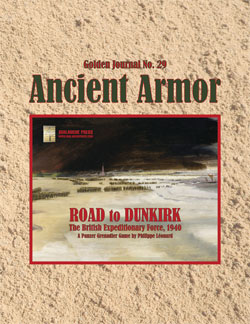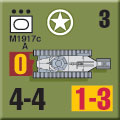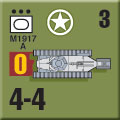| Golden Journal No. 29:
The AEF’s Light Tank
by Mike Bennighof, Ph.D.
August 2022
 The American Expeditionary Forces’ desire to found their own Tank Corps arrived just as the French introduced the new Renault FT17 light tank. The American observers fell in love with the little tank, and the U.S. Army quickly purchased it to equip its light tank battalions. The American Expeditionary Forces’ desire to found their own Tank Corps arrived just as the French introduced the new Renault FT17 light tank. The American observers fell in love with the little tank, and the U.S. Army quickly purchased it to equip its light tank battalions.
The first modern tank originated with Louis Renault, the deeply unpleasant founder of the Renault automobile firm. Renault had already entered war production, making 75mm artillery shells that suffered an alarming number of premature explosions. He apparently declined the French Army’s first approaches to enter tank production, but when they asked again in July 1916 he quickly had a prototype ready.
Other tanks had been slow and ungainly, vulnerable to enemy artillery and close-range infantry assault. Renault believed that their designers had tried to achieve too much given the capabilities of the engines then available. Instead of harnessing ever-larger, and less reliable, engines to bigger tanks, Renault proposed to build a tank that suited the best available power plant. That limited its weight to seven tons, a limit he enforced with the full screaming, abusive force of his foul personality.
The Renault FT (it gained the 17 only after the war) weighed in at 6.7 tons, and carried a crew of two, a driver and a gunner/commander. The 39-horsepower engine moved the little tank at 7.5 kilometers per hour, or a little less than five miles per hour. That still wasn’t enough to outrun a strolling infantryman, but the tank was intended to accompany the infantry, not to serve as armored cavalry.

An M1917 light tank in Hawaii, 1938.
The turret could accommodate either a single 8mm Hotchkiss machine gun (the “Female” version) or a short-barreled 37mm cannon (the “Male”); about two-thirds had machine guns and the remainder cannon. A variant of the “Male” model had a stubby 75mm howitzer instead. A small number had no armament at all and were fitted with a radio instead. The 22mm armor could fend off rifle and machine-gun fire, but would be vulnerable to enemy artillery – no tank of the First World War had armor that could defeat an artillery shell. The engine roared so loudly that communication inside the tank was impossible; the commander directed the driver by kicking him in the shoulders or head.
Production was approved in December 1916, but suspended so the French Army could review the British experience with heavy tanks. Finally in September 1917 Renault’s tank received the green light, and Renault as well as several sub-contractors began turning out the FT. Louis Renault waived all royalty payments during wartime.
Wartime production totaled 2,781 machines, by far the most of any tank built until much later. It first saw action in May 1918, and proved an immediate success. Though the little tanks individually lacked the firepower of the larger heavy tanks, the Germans had no answer for the swarms of them that struck their lines at the same time.
Capt. George S. Patton, the first officer assigned to the American Expeditionary Forces’ new Tank Corps, toured the Renault factory and offered a few suggestions. The armament should be made interchangeable, so that maintenance crews in the field could substitute the machine gun for the 37mm cannon and vice-versa. The fuel tank could be double-walled, and a bulkhead placed between the crew and the engine to reduce heat and noise and protect them from fire. Louis Renault of course ignored the impertinent American; several French officers cautioned Patton that offering such feedback was a waste of time.

Marine Corps M1917 light tanks in China.
Even so, Patton became an enthusiastic backer of the Renault tank. The Americans received 144 French-made tanks, and ordered 4,440 more from American manufacturers as the licensed M1917 Light Tank. The AEF expected the first delivery in April 1918, but none were completed before the Great War came to a close.
The M1917 was a close copy of the Renault FT, but not an exact one. It had an American engine, and an American Colt-Browning machine gun in those armed with a machine gun (the cannon-armed versions had a French 37mm gun). All M1917 tanks had an octagonal turret (some French-made tanks had a circular turret), and all of the wheels were sold steel rather than spoked. It also had the engine bulkhead and a self-starter for the engine, improvements originally suggested by Patton.
No M1917 tanks made it to the front during the Great War; the first ten production models only arrived in France in the last weeks of 1918, after the Armistice had brought an end to the fighting. Production continued at three different factories, eventually totaling 950 machines before the War Department cancelled the rest of the order. In addition, the U.S. Army brought home about 200 Renault-made machines from France; these were also classed as M1917 light tanks. The Americans, like the French, deployed the machine-gun armed tanks alongside the cannon-armed vehicles in the same platoons to allow them to support one another.

Fake news, 1932 style. An M1917 and horsed cavalry intimidate American veterans of the Bonus Army. George Patton would later claim this never happened.
The M1917 went to the post-war tank regiments, just like the Liberty heavy tank, and to independent tank companies in both the Regular Army and the National Guard. These latter were deployed regularly through the 1920’s and 1930’s to intimidate striking industrial workers. Douglas MacArthur famously used M1917 light tanks to break up the Bonus Army of desperate veterans in Washington, D.C.
 The Army loaned three M1917 tanks to the Marine Corps in late 1923, and then six more two years later, giving the Marines a total of eight (one tank apparently was returned). The Marines formed a light tank platoon for their 1924 maneuvers, but then re-assigned its personnel to mail guard duty. The platoon re-assembled in 1926 for deployment to China, remaining in Tientsin until 1928 when they returned to San Diego. The crews went on to other duties while the tanks went into storage. The Marines sold them for scrap in 1935. The Army loaned three M1917 tanks to the Marine Corps in late 1923, and then six more two years later, giving the Marines a total of eight (one tank apparently was returned). The Marines formed a light tank platoon for their 1924 maneuvers, but then re-assigned its personnel to mail guard duty. The platoon re-assembled in 1926 for deployment to China, remaining in Tientsin until 1928 when they returned to San Diego. The crews went on to other duties while the tanks went into storage. The Marines sold them for scrap in 1935.
By 1940 the last of the Army’s independent companies had been phased out, and their little light tanks moved into storage as well. The Royal Canadian Army bought 236 of them to issue to training units, and that appears to be all that were left by that point, with the others having been scrapped as they broke down.
 We included both versions (cannon and machine gun) in our Golden Journal No. 29: Ancient Armor. The huge stockpile of light tanks worked against their modernization; when a tank broke down it was discarded rather than repaired, since there were plenty more in the depots. Other nations still had the Renault FT in service when World War II broke out (almost always on secondary duties), and the U.S. Army could have done so as well; with so many tanks already on hand, obtaining funding for new ones became very difficult. We included both versions (cannon and machine gun) in our Golden Journal No. 29: Ancient Armor. The huge stockpile of light tanks worked against their modernization; when a tank broke down it was discarded rather than repaired, since there were plenty more in the depots. Other nations still had the Renault FT in service when World War II broke out (almost always on secondary duties), and the U.S. Army could have done so as well; with so many tanks already on hand, obtaining funding for new ones became very difficult.
In our variant, they’ve been refurbished and deployed to Ireland in 1940 to take on the Germans, and Guam in 1941 to take on the Japanese. You’ll need Panzer Grenadier: Road to Dunkirk and Saipan 1944 to play with your new old tanks.
Click here to join the Gold Club.
See your Gold Club Insider newsletter for ordering information.
Sign up for our newsletter right here. Your info will never be sold or transferred; we'll just use it to update you on new games and new offers.
Mike Bennighof is president of Avalanche Press and holds a doctorate in history from Emory University. A Fulbright Scholar and NASA Journalist in Space finalist, he has published a great many books, games and articles on historical subjects; people are saying that some of them are actually good.
He lives in Birmingham, Alabama with his wife and three children. He will never forget his Iron Dog, Leopold.
Want to keep Daily Content free of third-party ads? You can send us some love (and cash) through this link right here.
|
